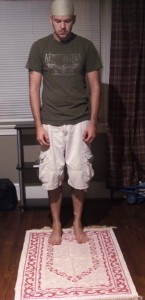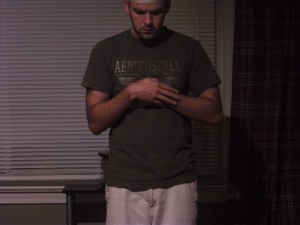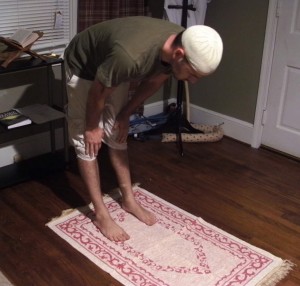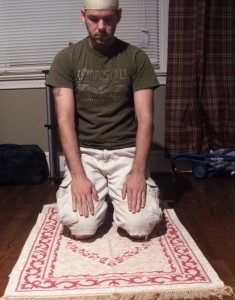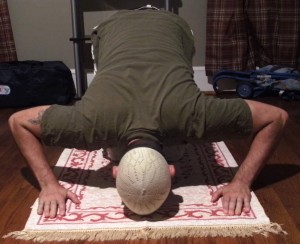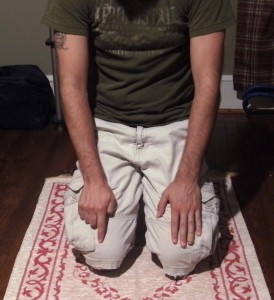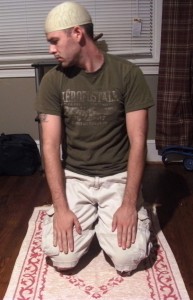If there’s one thing my Muslim brothers and sisters have down, it’s prayer. For most greenhorn converts (or reverts, as Muslims call them), the only aspect of Islam more intimidating than the Arabic terms and phrases is the method of prayer. The best thing about Islamic prayer though, is that there’s lots of time for practice…five times a day, in fact.
Prayer is the second pillar of the Islamic faith and referred to as Salat. It comes in second place to faith because, well, if you didn’t have faith in God, what would be the point in praying to him? Prayer to Allah then is a way to ask for blessings, protection, forgiveness, and give thanks. The Qur’an prescribes prayer for the Muslim five times a day in order to help them stay focused on Allah at all times. The five times are:
- Dawn (Fajr)
- Early Afternoon (Zuhr)
- Late Afternoon (Asr)
- Sunset (Maghrib)
- Night Prayer (Isha)
Of course we can pray to Allah anytime we choose. These are simply the obligatory times.
When I first read over the prayer schedule I thought, “Sheesh that’s a lot of prayer! Do Muslims have time for anything else?”
Well, yeah…once you learn how to pray correctly, even the longest prayer (which consists of 4 units called rakah’s) only takes about seven to ten minutes. In fact, because there is a lot of movement involved in the prayers, it reminded me of the yoga asanas I used to do every morning, noon, and evening for my month with Hinduism. Masha’Allah (as God has willed), I love it when I discover a common thread among faiths.
Okay, enough jabbering. I’ll bet you want to see photos of me performing salat only three days into my month with Islam. Be ye warned, it’s a bit awkward getting used to the prayer movements and the Arabic words. My recommendation is that you focus on the motions first, then learn the prayers in your native language, and then try on the Arabic. As one person on here told me, Allah cares more about sincere intention than perfect execution. Let’s get started.
Salat: Four rakah’s (units)
Each prayer varies on how many units you go through. Four is the max, so I’ll go all the way through.
1) The intention to pray. Much of prayer is recited in one’s mind. Here, you set your intention to pray with acknowledging which prayer (time of day) you are performing and how many units it consists of. Notice the prayer rug. Once you perform wudu (ritual cleansing of your hands, arms, nostrils, mouth, face, ears, hair, and feet), this rug is like holy ground. I am also facing the qiblah, the direction all Muslims turn to toward Mecca (where the Kabba is housed in Saudi Arabia). Can you imagine? Each time you pray, it’s in unison with thousands–perhaps millions–of fellow believers.
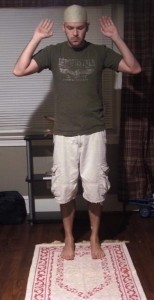
2) This step is called Takbeer. Raise your hands–palms and fingers up–to both sides of your head so that your hands are alongside your ears. Now declare “Allahu akbar”, meaning God is the greatest.
3) Look down and let your gaze rest on the spot where your forehead will eventually touch the ground. Rest your left hand against your chest and bring your right hand over the left. Notice that the middle fingers of my right hand lay on top of my left hand while my right thumb and pinky finger wrap around the wrist of my left hand. Looks easier in the pic, huh?
From here you will recite the following (for ease of use, I will only provide the English translation):
” You are glorified, Oh Allah, and praised. Your name is blessed, your majesty exhalted, and none has the right to be worshipped but you.”
“I seek refuge with Allah from Satan, the cursed one.”
*Special note: You will not say this first part again as you go through the remaining rakah’s, so it’s more like an intro*
Continue from here while in the same posture and recite the first sura (chapter) of the Qur’an, al-Fatiha:
“In the name of Allah, the Beneficent, the Merciful. Praise be to Allah, Lord of the worlds, the Beneficient, the Merciful, Master of the Day of Judgement. Thee alone we worship and to Thee alone we turn for help. Guide us in the straight path, the path of those whom You favoured and who did not deserve Thy anger, or went astray.”
From here, you may recite any short passage from the Qur’an you like. This step is only for the first and second rakat and therefore will not be repeated for the third and fourth.
4) This step is called Ruku. Say “Allahu Akbar” as you bow. Keep your back straight, your eyes fixed on the same spot, and your hands on your knees. Once you are bowing, recite three times, “Glory to my Lord the great.” Once finished, recite, “Allah has heard all who praise Him,” as you rise, and then finish with “Our Lord praise be to Thee,” as you stand straight up.

After this “Allahu Akbar,” we go into Sajdah–prostration.
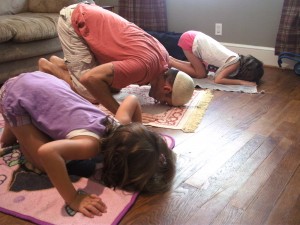
5) Here’s the proper prostration technique: make contact on the rug (or towel, or Dora blanket) with your forehead and the tip of your nose. Place palms of your hands flat on the floor beside your head. Make sure your knees and feet are together and that your feet are straight up with toes bent inward. While in this position, recite three times, “Glory to my God the Most High.” Then, rise up onto your knees…
6) With hands on knees and gaze fixed where your forehead was, say “Oh Allah, forgive me and have mercy on me.”
7) Repeat step 5.
Way to go! Once you stand back up, you have just completed your first rakah! Here’s a clue to make things easier: The first and third rakah’s are almost exactly the same. The only difference is that in the third rakah, you only recite the al-Fatiah sura in the beginning. Piece of falafel, right? Okay, on to the second rakah…
Second rakah, step 8: Stand up from the prostration and repeat steps 3-7, only leave out the first two intro statements. Then, sit back as in step 6 and recite the Tashahud, or bearing witness to the oneness of Allah:
“All prayers and worship through words, action, and sanctity are for Allah only. Peace be unto you, O Prophet and Mercy of Allah and His blessings. Peace be on us and on those who are righteous servants of Allah.”
9) Point the index finger of your right hand against your lap and look down at your finger as you say the Shahadah, the Islamic declaration of faith (there are a few variations, by the way):
“I bear witness that there is no god but God, and that Muhammad is His messenger.”
This ends the second rakah. Only the dawn prayer (Fajr) contains but two rakahs.
Third rakah: As I mentioned before, the third rakah and the first are almost exactly the same. To perform the third rakah, only leave out those first two introductory statements and the extra Qur’an passage. Once you have reached the end (kneeing on the floor), stand up and begin the forth and final rakah from step 3.
To complete the fourth rakah, repeat steps 3-9 and then finish with the following step:
10) Say an additional prayer, such as a short passage from the Qur’an, giving thanks, or asking forgiveness.
11) Turn to the right and say, “Peace be unto you and Allah’s blessings.” Then turn to the left and say the same. Keep in mind, this movement assumes you are in a masjid (mosque) with other Muslims.
High five! You just prayed Islamic style. Ishallah, I didn’t screw this up too much, and if I did, my Muslim brothers and sister will gently offer corrections in the comment section ; )
Here is a fantastic site one of our Muslim Congregation members offered as a way to learn the prayers.
What do you think about this prayer technique? If it seems odd or time-consuming, all I have to say is don’t knock it ’til you try it. The form is more satisfying to complete than it looks, you know, once you learn how.
